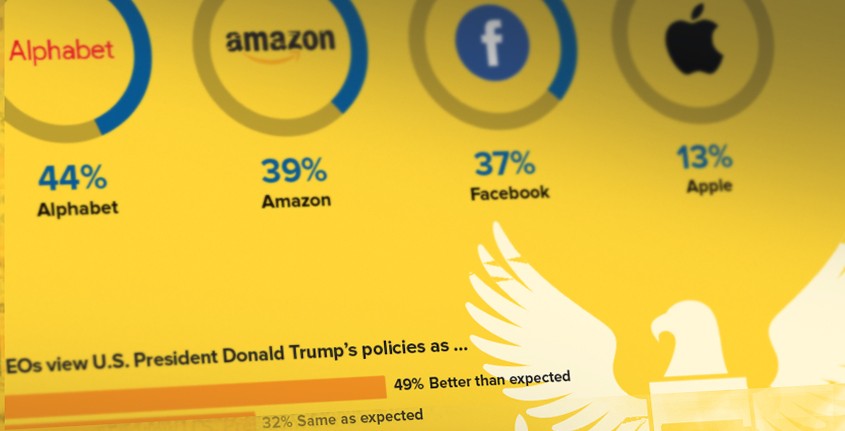Where Are the Female Directors?
The call for gender parity in the workplace has reached a fever pitch. The #MeToo movement and government regulations such as the United Kingdom’s mandated reporting on gender pay gaps have brought the issue to the forefront, forcing companies and executives to truly confront their bias—conscious or unconscious—toward women.
Yet despite all the headlines and the promise of progress, the uppermost echelon of the corporate world—the boardroom—remains decidedly male.
In Japan, for example, women accounted for a mere 3.7 percent of all officers at Tokyo Stock Exchange-listed companies, according to a 2017 survey by the country’s Cabinet Office. And, at Fortune 500 companies, women accounted for 38.3 percent of all newly appointed independent board seats in 2017, according to executive search firm Heidrick & Struggles. But look at the overall percentage of female board directors at these companies, and the figure drops to 22.2 percent. Heidrick & Struggles predicts that we will not see an even split in appointments for men and women at Fortune 500 companies until 2025.
“Our numbers are growing, but not fast enough,” says Irene Chang Britt, a former president of Pepperidge Farm with experience on several boards, including Brighthouse Financial, Tailored Brands and Dunkin’ Brands.
So what is the holdup? Why is the boardroom, which should be leading this change throughout organizations, moving at such a slow pace? Share on X
Excuses, Excuses
Part of the problem is an outdated mentality for choosing board members, says Sheila Penrose, chairman of the board of JLL, a global commercial real estate services and investment management company headquartered in Chicago.
“The traditional profile of a board member is a current CEO, and we all know the statistics on women running Fortune 500 companies—it’s about 5 percent,” she says. Many companies give up if a cursory search for a female CEO to join the board does not deliver a perfect candidate.
It is a sentiment driven home by the latest report from the United Kingdom’s Hampton-Alexander Review, an independent review body whose mission is to increase the number of women on Financial Times Stock Exchange (FTSE) boards and improve women’s representation in senior leadership positions. In the report, which surveyed a range of FTSE 350 chairs and CEOs, participants revealed why they have yet to appoint more women to the board. Their comments included things like, “There aren’t that many women with the right credentials and depth of experience to sit on the board—the issues covered are extremely complex.” “All the ‘good’ women have already been snapped up.” “We need to build the pipeline from the bottom—there just aren’t enough senior women in this sector.”
The problem, however, is not related to supply, Ms. Penrose says. It is an issue of perspective.
“While ‘CEO’ is a favorable profile, it’s not the only profile that makes a good board member,” she says. Instead, she believes an effective board should have a diversity of experience that comes from experts in finance, marketing, technology and other areas of business. “There are plenty of qualified women who fit these profiles and would be effective board directors. Companies just need to broaden their aperture of what a relevant candidate looks like.”
Unfortunately, the struggle goes beyond finding the right female candidate. Boards will often take a one-and-done approach: recruiting one female and declaring victory. One commenter in the Hampton-Alexander Review put it this way, “We have one woman already on the board, so we are done. It is someone else’s turn.”
Ms. Penrose, who sits with three other women on the JLL board of directors, notes that simply bringing a token female to the table limits her ability to influence change. “When there is only one woman, the board expects her to respond to every issue that is relevant to women,” she says. “But when there are several woman on the board, it’s not the voice of the woman—it’s the voice of the directors.”
Having more than one woman on the board also prevents a single voice of dissent from being ignored, Ms. Britt says. “When there is more than one woman on the board, questions are asked differently,” she says. “It helps the board move away from a groupthink mentality.”
The Female Voice
When companies are willing to consider non-CEO executives for these roles, not only does it make more room for women, it opens companies up to a broader set of experiences, perspectives and personal networks. Each of those things can help the business. A famous study of Fortune 500 companies shows that those with more female board members reported a 42 percent greater return on sales and a 53 percent higher return on equity than their male-dominated competitors.
“As women on boards, we’ve all had to deal with these issues in our careers, so we bring that perspective to the conversation.”
—Linda Goodspeed, board director, Autozone, American Electric Power and Darling Ingredients
But the benefits of boardroom diversity go well beyond the bottom line, says Linda Goodspeed. She sits on the boards of AutoZone, American Electric Power and Darling Ingredients. “More diversity of thought in the boardroom drives better decisions for the business,” she says.
Ms. Goodspeed recalls speaking to a group of women at an AutoZone employee event where she expected a few quick questions at the end. Instead she spent 45 minutes responding to a flood of questions about her own career and how they could get ahead. “The female employees were starved for information about how to build their careers,” she says. It helped her recognize how important female mentors were to the women in the company. With the support of the board, AutoZone management continuously looks at more female-friendly policies, including more flex-time options and better access to child care. “As women on boards, we’ve all had to deal with these issues in our careers, so we bring that perspective to the conversation.”
Having female representation at the top causes everyone on the board to talk more openly about diversity and to seek it out in the company, Ms. Penrose says. “People look up to see who’s on the board, and the board looks down to see how the company is progressing.” She notes that when the board is thinking about diversity, it is reflected in the priorities it sets for the company.
At JLL, that includes making sure there is diversity in the ranks of high-potential employees and that they all find opportunities to move ahead in their careers. “Gender and ethnic diversity is part of every conversation we have around talent development,” Ms. Penrose says. That has helped JLL achieve 60 percent more female representation in senior leadership than the industry standard, she says. “It’s not just women raising other women. Men are focused on it as well.”
Women can also recognize problems that men might overlook. For example, Ms. Goodspeed recalls touring a facility for one of the other three boards she sits on and noticing discriminatory graffiti on an outside wall and poor lighting. “I grew up in Detroit and learned that walking down dark alleys is dangerous,” she says. She pointed out that the area was not safe for female employees, and the men in the group admitted they had not recognized that it was a problem. “It opened their eyes to issues they wouldn’t have considered.”
Breaking the Ice
Regardless of whether a woman is the first female board member or the fifth, finding her voice on the board can take some time.
“While ‘CEO’ is a favorable profile, it’s not the only profile that makes a good board member.”
—Sheila Penrose, chairman of the board, JLL
Ms. Goodspeed admits that early on in her boardroom career, she was not always comfortable speaking up. She took her first board position in 2004 at Columbus McKinnon, a global manufacturer of material handling products. She was 42 years old—20 years younger than everyone else on the board and the only woman. “Although they welcomed me on the board, it took me a while to position myself to best contribute,” she says. The board had sought her out, and members made a point of asking her opinion and encouraging her to speak if she held back. “They really wanted the perspective of a woman with a manufacturing and technical background,” she says.
Though Ms. Goodspeed still sometimes feels as if she stands out after joining a board, she has never felt overt discrimination. Ms. Goodspeed is typically sought out because of her technical, industry and boardroom experience, so most directors recognize the expertise she brings to the table from day one. “There might be a particular board member here or there who questions whether this woman will really add value, but that changes over time when they see the experience I bring.”
To ease these transitions, female board members should actively attempt to build relationships with their peers, both in the boardroom and outside of it. Ms. Penrose notes that female executives tend to spend less time on social networking but these interactions are critical for fitting into a board, especially as it may only meet a few times a year. “If they don’t know you or they aren’t on your committee, they don’t know what you can contribute,” she says. “But when you make the effort to have conversations and to connect socially, that bias will vanish and they will start to see where you add value.”
Ultimately, bringing more females into the boardroom is a change that women themselves will have to lead. Ms. Goodspeed, for example, was the only woman on the AutoZone board when the other female board member, Sue Gove, retired after 13 years on the board. She notes that Ms. Gove helped build AutoZone’s women’s council and encouraged the executive team to promote female high performers and set metrics for how well management promoted diversity in the company. Ms. Goodspeed is continuing those efforts. Since her retirement, the board has assigned two additional women to the board.
On most of the boards Ms. Britt sits on, she is the chair of nominating and corporate governance, which positions her to seek out new board members. While she does not exclusively look for women, she ensures every slate has strong female candidates who align with the future needs of the company. She also does not limit her list to people in the board’s close network. For example, Dunkin’ Brands needed someone with deep marketing experience, and the chief marketing officer at General Electric made the list. “She’d never been on a board, but she was exactly what we needed for the company’s strategy, so she rose to the top.”
This trend is being driven forward by organizations like the Thirty Percent Coalition, Women Corporate Directors and Catalyst, Ms. Britt says. “They are making tangible progress in getting more women on boards.” Despite the slow pace of change, she is optimistic: Gender parity on boards “will one day become the norm.”




